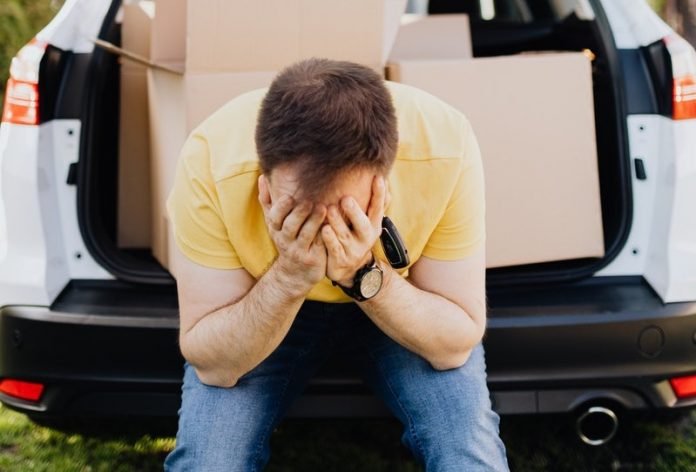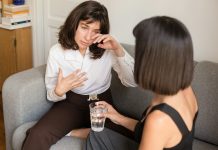
Denise Santos remembers exactly how she felt when the first pandemic lockdown was ordered last year, knowing she’d no longer have to interact with the public, her co-workers or anybody outside the sanctuary of her home.
“The relief was immediate and almost overwhelming, like I’d slid into a warm bath,” said Santos, who is one of 15 million Americans living with social anxiety.
Now, more than a year later, as vaccination rates rise, restrictions loosen and social activity resumes, the sounds of backyard barbecues, the sight of bigger crowds at local stores and the thought of entering a public workspace make her heart race.
“I’m getting shortness of breath just thinking about it,” she said.
Anxiety disorders include generalized anxiety disorder, panic disorder and phobia-related disorders.
They are the most common form of mental illness in the United States, affecting more than 40 million adults, or 18% of the population. Symptoms vary and can interfere with daily life.
For example, people with social anxiety – an intense fear of any interaction with others – can experience physical symptoms such as a rapid heart rate or nausea, in addition to feelings of stress, embarrassment or fear of being judged.
Over time, this type of prolonged stress can harm heart and brain health.
For Santos and others with anxiety disorders, the pandemic brought an unexpected release, even as they also felt concern over potential exposure to the coronavirus.
In late February, an American Psychological Association online survey of 3,013 U.S. adults found that while 47% of respondents felt a rise in stress levels during the pandemic, 7% actually felt stress levels go down – roughly the same percentage of the population that lives with social anxiety.
But now as the return to pre-pandemic life accelerates, those who felt protected by the normalization of homebound life are feeling anxieties ramp up – and even those without anxiety disorders find they aren’t as excited about the return to normal life as they expected to be.
Nearly half of those surveyed by the APA said they felt uneasy about returning to in-person interactions, whether they had been vaccinated or not.
Doug Levy is one of them. He didn’t have anxiety before the pandemic, but after more than a full year of strict safety protocols that included diligent masking, social distancing and avoiding crowded public spaces, he now finds it hard to enter restaurants and other places he conditioned himself to avoid – even though he is fully vaccinated.
“I want to be out and about,” he said, “but I’m not sure I’m ready.”
Levy has canceled social plans with other vaccinated friends, even though he knows the Centers for Disease Control and Prevention considers small gatherings of vaccinated people to be safe.
As teachers and children return to classrooms, as gyms and entertainment venues reopen and as many return to the workplace, feelings of stress and anxiety are to be expected, said Marney White, a clinical psychologist at the Yale School of Public Health in New Haven, Connecticut.
“Any type of life change is associated with stress and anxiety,” said White, who also is an associate professor of public health. “Even if the change is exciting.”
But with COVID-19 still spreading and the increased threat of variants in some areas, there’s also plenty of reason to remain concerned, White said.
“The vaccine rollout is going really well, and there is cause for optimism, but unfortunately we are not outrunning the virus right now.”
Anxiety is defined as a reaction that is disproportionate to the threat, she said, “and in this case, it is not disproportionate.”
“A lot of anxiety is around simply not knowing or not being able to accurately gauge the risk. You don’t know if someone who is not wearing a mask has been vaccinated,” White said.
“Unfortunately, there are a lot of local governments not enforcing mask mandates so people in those areas who take this seriously would be appropriately anxious about that.”
White said people should continue to engage in best health practices, such as following CDC guidance for wearing a face covering, practicing social distancing and limiting higher risk activities, such as indoor dining.
And at work, employees shouldn’t hesitate to ask for protections, she said.
For low-risk situations, such as small gatherings of fully vaccinated people, if anxieties persist, White recommends a method known as systematic desensitization, or “fading.”
This involves gradually re-introducing anxiety-provoking activities until they begin to feel normal again.
“Outdoor get-togethers are a good place to start,” she said. “The more you engage in these situations, the more normal they will feel. Over time, the initial anxiety will fade.”
Dr. Helen Lavretsky, a professor of psychiatry at the University of California, Los Angeles, said finding ways to cope with anxiety and other stressors is important to maintaining good physical health.
“Chronic stress is probably the biggest contributor to disorders of aging, such as heart disease, depression, Alzheimer’s disease and other forms of dementia,” said Lavretsky, who co-authored an American Heart Association report on the connection between mental and physical health.
At her clinic in Los Angeles, Lavretsky teaches people how to restore emotional balance when faced with situations outside of their control, using diet and practices such as yoga, tai chi, meditation and breathing exercises.
One simple action is to take slow, deep breaths, and hold each for three seconds before releasing. “Do this for five minutes while listening to quiet music,” she said.
“That practice alone will drop your blood pressure and heart rate. And you always have this tool in your possession.”
Lavretsky also recommends reframing negative thoughts: “Ask yourself, ‘How is this a gift to me? What is the positive experience, the silver lining?’
This changes your perception of reality from ‘I feel bad’ to seeing what is good about the situation. Just that alone will help to de-stress you.”
If you care about anxiety, please read studies about single dose of this drug may help reduce anxiety and depression for a long time and findings of a new treatment for depression, anxiety.
For more information about anxiety prevention and treatment, please see recent studies about a major cause of social anxiety disorder and results showing that common anxiety and sleep drug may lead to dangerous addiction.



